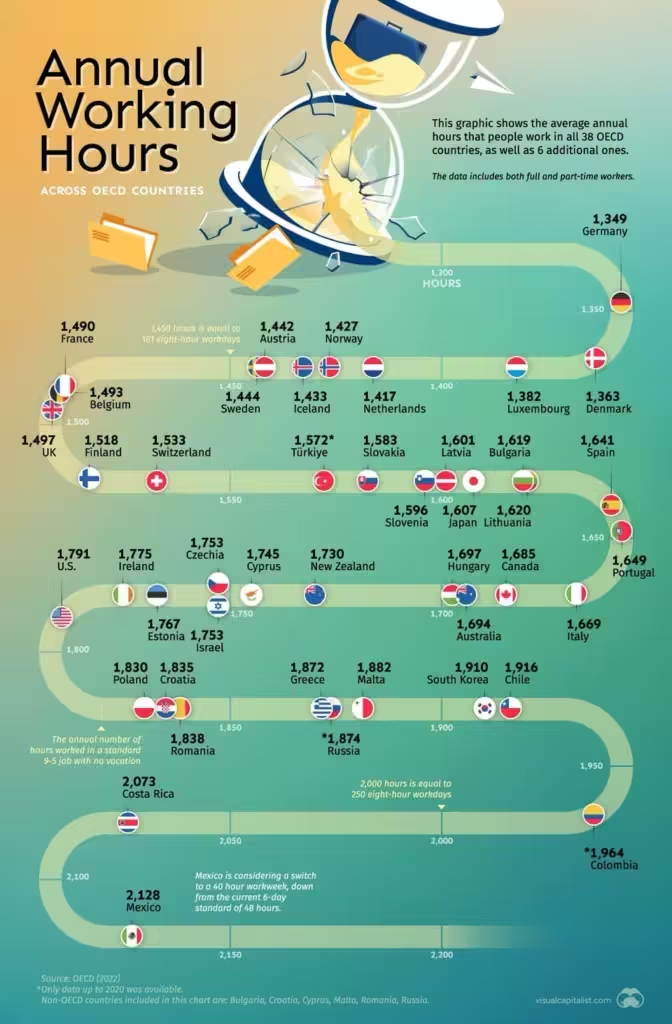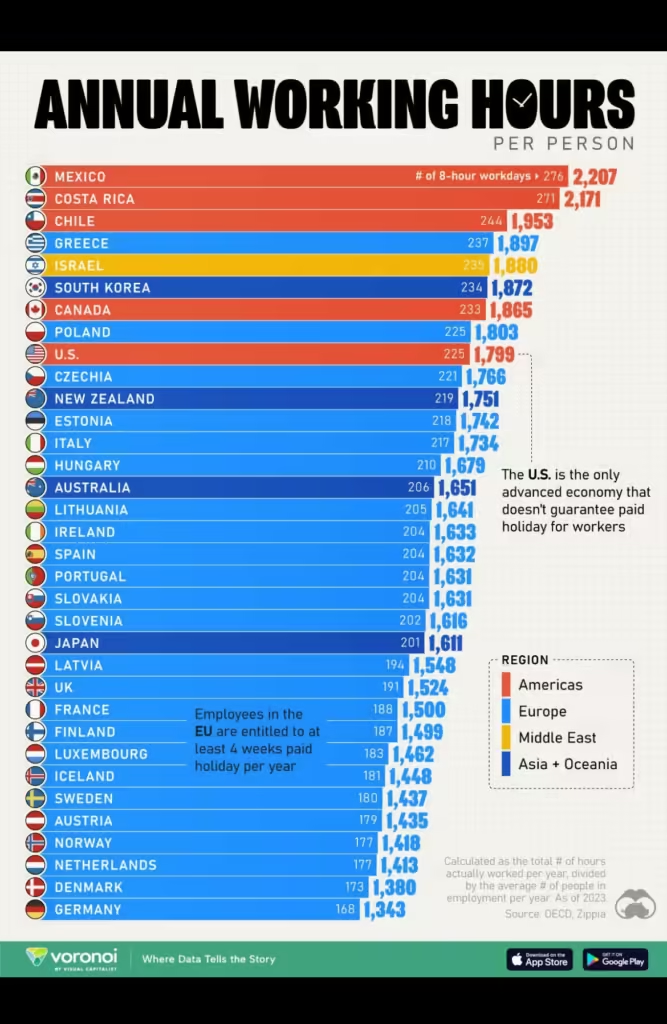How much do you work annually? A Comprehensive Analysis of Annual Working Hours by Country
In today’s fast-paced global economy, understanding the nuances of working hours across different countries can provide valuable insights into productivity, work-life balance, and cultural attitudes towards labor. This article delves into the annual working hours per person in various countries, offering a comprehensive analysis of global work patterns and their implications.
The Global Spectrum of Annual Working Hours
Mexico: The Hardest Working Nation
At the top of the list, Mexico stands out with an astounding 2,207 annual working hours per person, equivalent to 276 eight-hour workdays. This figure reflects a work culture that prioritizes long hours, potentially at the expense of work-life balance.
European Work Ethic: A Contrast in Approach
On the other end of the spectrum, European countries, particularly in Northern and Western Europe, showcase significantly lower annual working hours:
- Germany: 1,343 hours (168 days)
- Denmark: 1,380 hours (173 days)
- Norway and Netherlands: 1,418 hours (177 days)
These figures highlight a stark contrast in work cultures, with European nations emphasizing efficiency and work-life balance over sheer hours worked.

The American Paradox
The United States, often perceived as having a demanding work culture, ranks 9th on the list with 1,799 annual working hours (225 days). This places it significantly below Mexico but above most European countries, reflecting a middle ground in the global work hour spectrum.
Asian Work Cultures: Varying Approaches
Asian countries exhibit diverse work hour patterns:
- South Korea: 1,872 hours (234 days)
- Japan: 1,611 hours (201 days)
These figures suggest that while some Asian economies maintain long working hours, others have made efforts to reduce work time, possibly in response to concerns about overwork and its societal impacts.

Factors Influencing Annual Working Hours
- Economic Development
Generally, more economically developed countries tend to have shorter working hours. This trend is evident in the contrast between countries like Mexico and Germany. - Labor Laws and Regulations
The European Union’s mandate of at least 4 weeks paid holiday per year significantly impacts the annual working hours in EU member states. - Cultural Attitudes
Cultural perceptions of work ethic and productivity play a crucial role. For instance, the “work hard” ethic in countries like Mexico and South Korea contributes to longer hours. - Productivity and Efficiency
Countries with lower working hours often compensate with higher productivity per hour worked, as seen in many Northern European nations. - Sector Composition
The dominant industries in a country can influence working hours. Service-based economies might have different patterns compared to manufacturing-heavy ones.

Implications of Annual Working Hour Disparities
- Work-Life Balance
Countries with lower annual working hours often report higher levels of work-life balance and overall life satisfaction. - Health and Well-being
Excessive working hours can lead to stress, burnout, and various health issues, potentially impacting national healthcare systems. - Economic Productivity
While longer hours might seem to indicate higher productivity, countries like Germany demonstrate that efficiency can lead to strong economic output despite fewer working hours. - Social Dynamics
Working patterns significantly influence family structures, social interactions, and community engagement.
The U.S. Exception: Lack of Guaranteed Paid Holidays
A notable observation is that the United States is the only advanced economy that doesn’t guarantee paid holidays for workers. This policy gap contributes to its higher annual working hours compared to other developed nations.
Regional Trends
- Americas: Generally higher working hours, with Mexico, Costa Rica, and Chile leading.
- Europe: Lower working hours, especially in Western and Northern Europe.
- Middle East: Limited data, with Israel showing moderate working hours.
- Asia and Oceania: Varied patterns, with South Korea working longer hours than Japan or Australia.
The Future of Work Hours
As global discussions on work-life balance, productivity, and employee well-being continue to evolve, we may see shifts in these patterns:
- Remote Work Impact: The rise of remote work could blur the lines between work and personal time.
- Four-Day Workweek Experiments: Some countries are trialing shortened workweeks to boost productivity and employee satisfaction.
- Automation and AI: These technologies might reduce working hours in certain sectors.
The analysis of annual working hours per person across different countries reveals a complex interplay of economic, cultural, and policy factors. While some nations maintain long working hours, others have successfully reduced work time without compromising economic output.
As the global economy continues to evolve, countries may need to reassess their approach to work hours, balancing productivity with employee well-being and societal health. The stark contrasts observed, particularly between countries like Mexico and Germany, highlight the potential for significant changes in how we approach work globally.
Understanding these patterns is crucial for policymakers, businesses, and individuals alike. It provides a foundation for informed decisions about labor practices, work-life balance initiatives, and productivity strategies in an increasingly interconnected global economy.
Share This Story
latest for you
Now loading...
news via inbox
Always stay updated with latest trends. Leave your email here!
In case you missed!
Recommended For You
Now loading...













